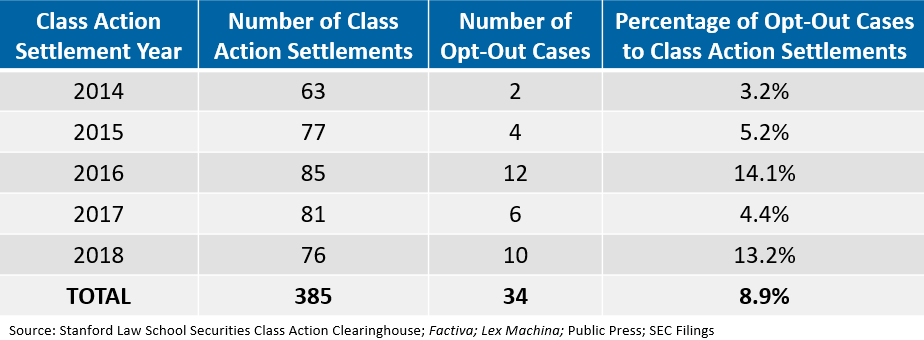Is Now the Time for Opt-Out Services?
In the United States, opting out of securities class actions to pursue direct suits has proven a source of significant value for some institutional investors. However, the strategy behind it comes with several challenges, from identifying and evaluating the best possible candidates to setting loss thresholds that make sense for the risks.
In the next five years, we will likely see a continued increase in the number of institutions that get involved in direct suits. Insight from Cornerstone Research published last year found that prior to 2014, the rate of opt-outs in class action settlements was 3.4%, compared to 8.9% between 2014 and 2018.

As the number of settlements increases, significant challenges arise for in-house counsels including keeping on track of impending deadlines and staying organized. Case grading analysis that includes an estimation of losses enables investors with the tools to quickly determine whether they are enough to consider opting out of the class. By leveraging the earliest, most comprehensive and objective view of all filed securities cases, investors are armed with the tools they need to weed out the noise and focus on those most important.
Opt-out services can provide a myriad of benefits for investors. While larger settlements are likely to yield more opt-outs, the return for investors still often ends up larger than that of an investor that chose not to leverage an opt-out service. For many investors, the ability to have control over their claims is also a huge benefit. Finally, if time is of the essence, opt-outs allow for a more rapid process of receiving the end payout. Many investors find this to be the largest benefit to opt-out services given the months or even years for administrations of class settlements.
While there are numerous benefits to leveraging an opt-out service, the strategy does come with its own set of challenges and can vary in success depending on the circumstances. In a sea of opportunities, it can be difficult to identify and evaluate the best candidates. Many investors also find it hard to understand what loss thresholds make sense for direct actions and to quickly determine whether their losses exceed it. Additionally, knowing the relevant time limits on filing and proactively engaging securities counsel on a more informed basis can be difficult.
Deciding the optimal time in a class action suit is one of the most challenging parts and why many investors rely on third-party solutions to ease any potential hiccups, and as such, unlock the most value out of every suitable opportunity.





